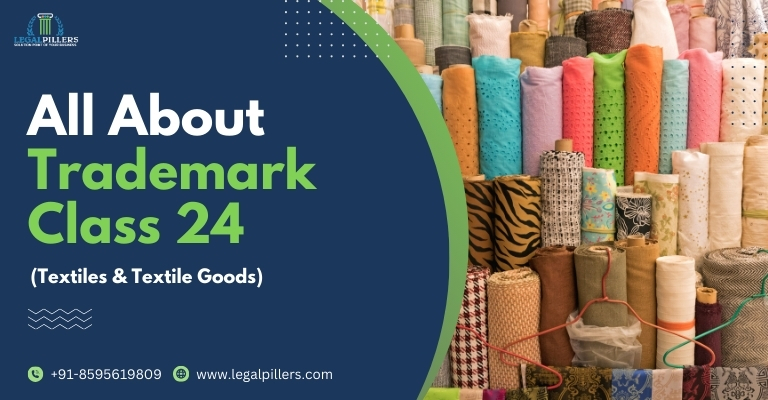
Table of Contents
All About Trademark Class 24
Trademark Class 24 is one of the 45 classes established by the Nice Classification system for goods and services. It primarily includes textiles and textile goods, such as fabrics, bed and table covers, curtains, and other materials used for clothing, upholstery, and household purposes. Class 24 also covers certain items made from textile materials, like towels and handkerchiefs, and certain textile goods not included in other classes, like flags and banners. Essentially, it encompasses a wide range of textile and fabric-related products, making it an important category for businesses seeking to protect their brand names and logos associated with these goods.
Important Goods included in Trademark Class 24
Trademark class 24 mainly includes fabrics and fabric covers for household use. The goods that have been covered under this class of trademark are as given below-
- Household linen, for instance, bedspreads, pillow shams, towels of textile.
- Bed linen of paper
- Sleeping bags, sleeping bag liners
- Mosquito nets
Goods does not included in Trademark Class 24
- Electrically heated blankets, for medical purposes (included in class 10)
- Electrically heated blankets, not for medical purposes (included in class 11)
- Table linen of paper (included in class 16)
- Asbestos safety curtains (included in class 17)
- Bamboo curtains and bead curtains for decoration (included in class 20)
- Horse blankets (included in class 18)
- Certain textiles and fabrics for specific uses, for example,-
- Fabrics for bookbinding (included in class 16)
- Insulating fabrics (included in class 17)
- Geotextiles (included in class 19)
List of popular examples of Trademark Class 24
- Cottonelle®: This trademark is registered for toilet paper and other paper products used for personal hygiene.
- Levi’s®: Levi’s, a well-known clothing brand, has registered its trademark in this class for various clothing items, including denim jeans.
- Pampers®: Pampers, a brand of disposable diapers, has its trademark registered in this class for diaper products.
- Marimekko®: Marimekko is a Finnish design company known for its distinctive fabric and textile patterns. Their trademark is registered in this class for textiles, fabrics, and home textiles.
- IKEA®: IKEA, a global furniture and home furnishings retailer, has its trademark registered in this class for various textile goods, including curtains, bed linens, and towels.
- Quilted Northern®: This trademark is registered for toilet paper and related paper products.
- Lululemon®: Lululemon Athletica, an athletic apparel brand, has its trademark registered in this class for various clothing items, including yoga pants and activewear made from textiles.
- Calvin Klein®: The Calvin Klein brand, known for its fashion and lifestyle products, has its trademark registered in Class 24 for clothing and textile goods.
- Laura Ashley®: Laura Ashley is a British brand known for its floral and home textile designs. Their trademark is registered in Class 24 for various textile products, including fabrics and bed linens.
- Silk®: The Silk brand, which produces plant-based milk products, has its trademark registered in this class for non-dairy milk products.
List of goods classified under Trademark Class 24
A
- Adhesive fabric for application by heat
- Adhesive tags of textiles for bags
B
- Baby buntings
- Banners of textile or plastic
- Bath linen, except clothing
- Bath mitts
- Bed covers/ bedspreads/ coverlets [bedspreads]/ quilts
- Bed covers of paper
- Bed linen
- Bedclothes
- Bed blankets
- Bed valances
- Bed sheets
- Bed sheets of leather
- Billiard cloth
- Bivouac sacks being covers for sleeping bags
- Blankets for household pets
- Bolting cloth
- Brocades
- Buckram
- Bunting of textile or plastic
C
- Calico
- Canvas for tapestry or embroidery
- Cheesecloth
- Chenille fabric
- Cheviots [cloth]
- Cloth*
- Cloths for removing make-up
- Coasters of textile
- Cot bumpers/ crib bumpers [bed linen]
- Cotton fabrics
- Covers [loose] for furniture or loose covers for furniture
- Covers for cushions
- Crepe [fabric]
- Crepon
- Curtain holders of textile material
- Curtains of textile or plastic
D
- Damask
- Diaper-changing clothes for babies
- Diapered linen
- Dimity
- Door curtains
- Drugget
E
- Eiderdowns [down coverlets]
- Elastic woven fabrics
- Esparto fabric
F
- Fabric, impervious to gases, for aeronautical balloons
- Fabric imitating animal skins
- Fabric*
- Fabric for footwear
- Face towels of textile
- Felt*
- Fiberglass fabrics for textile use
- Filtering materials of textile
- Fitted toilet lid covers of fabric
- Flags of textile or plastic
- Flannel [fabric]
- Frieze [cloth]
- Furniture coverings of plastic or coverings of plastic for furniture
- Furniture coverings made of textile
- Fustian
G
- Gauze [cloth]
- Glass cloths [towels]
- Gummed cloth, other than for stationery
H
- Haircloth [sackcloth]
- Handkerchiefs of textile
- Hatlinings, of textile, in the piece
- Hemp fabric
- Hemp cloth
- Household linen
J
- Jersey [fabric]
- Jute fabric
K
- Knitted fabric
L
- Labels of cloth
- Linen cloth
- Lingerie fabric
- Lining fabric for footwear
- Linings [textile]
M
- Marabouts [cloth]
- Mats of textile for beer glasses
- Mattress covers
- Moleskin [fabric]
- Mosquito nets
- Muslin fabric
N
- Net curtains
- Non-woven textile fabrics
O
- Oilcloth for use as tablecloths
P
- Picnic blankets
- Pillow shams
- Pillowcases
- Place mats of textile
- Plastic material [substitute for fabrics]
- Printed calico cloth
- Printers’ blankets of textile
R
- Ramie fabric
- Rayon fabric
- Reusable wax-coated fabrics for wrapping food
S
- Sew-on tags of textiles for clothing
- Shower curtains of textile or plastic
- Shrouds
- Silk fabrics for printing patterns
- Silk [cloth]
- Sleeping bag liners
- Sleeping bags for babies
T
- Table runners, not of paper
- Table linen, not paper
- Table napkins of textiles or serviettes of textiles
- Tablecloths, not of paper.
- Tablemats of textile.
- Taffeta [cloth]
- Tea towels/ dish towels
- Textile material
- Tick [linen]
- Ticks [mattress covers]
- Towels of textile
- Traced cloths for embroidery / traced cloth for embroidery
- Travelling rugs [lap robes]
- Trellis [cloth]
- Tulle
U
- Upholstery fabrics
V
- Velvet
W
- Wall hangings of textile/ tapestry [wall hangings], of textile
- Woollen cloth or woollen fabric
Y
- Yoga blankets
- Yoga towels
Z
- Zephyr [cloth]
Conclusion
Trademarks registered in Class 24 primarily encompass textile and fabric goods, as well as some related products. Businesses and brands that deal with textiles, fabrics, clothing, and similar items typically register their trademarks in this class to protect their brand identity and prevent others from using similar marks on similar products. These trademarks can cover a wide range of goods, including clothing, bedding, paper products, and more. By registering a trademark in this class, businesses can establish their brand presence and gain legal protection for their intellectual property in the textile and fabric industry.
At LegalPillers, we are here to navigate the complexities of trademark registration and classification effectively, making sure that your brand is adequately safeguarded within this important class.
FAQs related to trademarks in Class 24
What is Class 24 in trademark registration?
● Class 24 is a category used to classify and register trademarks for textiles and textile goods.
What types of goods are included in Class 24?
● Class 24 includes goods such as fabrics, bed linens, towels, textile piece goods, and textile materials for use in making clothing.
Do I need a trademark in Class 24 for my clothing brand?
● Yes, if you want to protect your brand name or logo on clothing items, you should register your trademark in the appropriate class, which may include Class 24 for certain textile goods.
How do I search for existing trademarks in Class 24?
● You can conduct a trademark search on the website of the United States Patent and Trademark Office (USPTO) or consult with a trademark attorney for a comprehensive search.
What is the registration process for a trademark in Class 24?
● The registration process involves filing an application with the USPTO, paying the required fees, and complying with their examination and publication procedures.
Can I register a trademark for a specific fabric pattern in Class 24?
● Yes, you can register a trademark for a specific fabric pattern if it is distinctive and serves as a source identifier for your goods.
Can I register a trademark for bed linens and curtains in Class 24?
● Yes, bed linens and curtains are common goods in Class 24, and you can register a trademark for them.
How long does it take to register a trademark in Class 24?
● The registration process can take several months to over a year, depending on various factors, including the complexity of your application.
What rights do I have as a trademark holder in Class 24?
● Trademark registration grants you exclusive rights to use the trademark on the specified goods in Class 24 and allows you to take legal action against infringement.
Do I need to renew my trademark registration in Class 24?
● Yes, you will need to renew your trademark registration periodically to maintain your rights. In the United States, this renewal is required every 10 years.
Can I use my trademark in Class 24 internationally?
● You can extend your trademark protection to other countries by filing for international trademark registration through the Madrid System or individual national trademark offices.
What happens if someone else uses a similar trademark in Class 24?
● If someone else uses a similar trademark for similar goods, it could lead to trademark infringement, and you may need to take legal action to protect your rights.
Is it necessary to work with a trademark attorney for Class 24 registration?
● While it is not required, working with a trademark attorney is often recommended to ensure a smooth and successful registration process.
Can I assign or license my Class 24 trademark to others?
● Yes, you can license or assign your trademark to others, but it should be done in accordance with trademark laws and regulations.
What is a “specimen” in the context of Class 24 trademark registration?
● A specimen is evidence that shows how your trademark is being used on the goods in Class 24. It is typically required during the application process.
Can I protect a three-dimensional (3D) design in Class 24?
● Yes, if a 3D design serves as a distinctive identifier for your textile goods, you can protect it with a trademark registration.
What is the difference between a trademark and a patent for textile-related inventions?
● Trademarks protect brand names and logos, while patents protect inventions and innovations, such as new textile manufacturing processes or machinery.
Can I cancel or challenge someone else’s trademark in Class 24?
● Yes, you can file a trademark cancellation or opposition if you believe another trademark in Class 24 conflicts with your rights.
What is the “Madrid System” for international trademark registration?
● The Madrid System is a global treaty that allows trademark owners to file for protection in multiple countries through a single application.
What is the cost of trademark registration in Class 24?
● The cost can vary depending on factors such as the filing method, the number of classes, and legal fees if you choose to work with an attorney. It is advisable to budget for both application and maintenance fees.



Leave a Reply